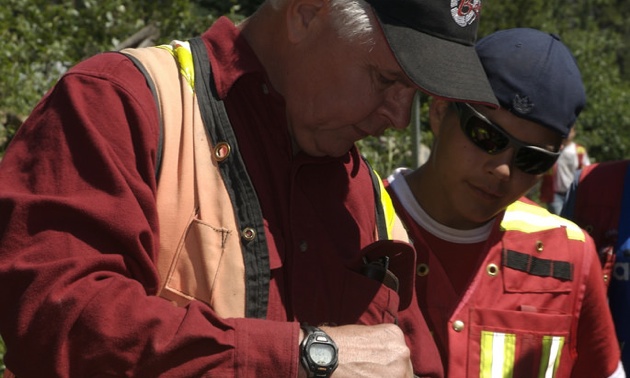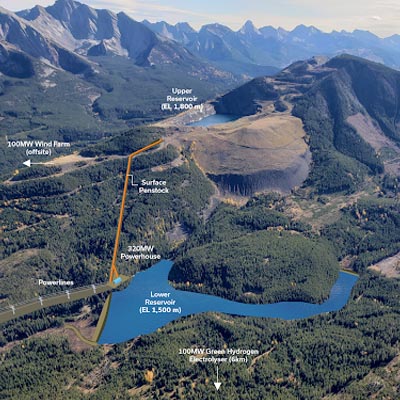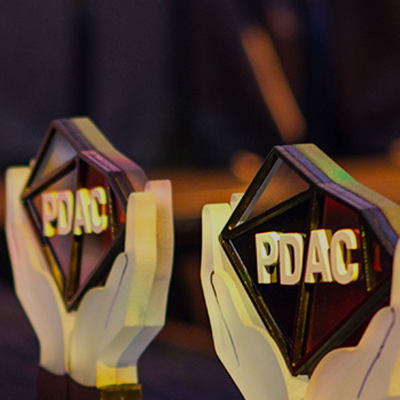A new book provides guidance on how to engage with First Nations
Engaging First Nations is important to the success of an exploration or mining project

Peter Ogryzlo, former mine geologist with Huckleberry Mines Ltd., in discussion with student from the School of Exploration & Mining. — Photo courtesy Northwest Community College School of Exploration & MIning
The Association for Mineral Exploration British Columbia (AME BC) has released a publication called Aboriginal Engagement Guidebook: A Practical and Principled Approach for Mineral Explorers. The guidebook is intended mainly for prospectors and early-stage explorers.
Lana Eagle is chair of the AME BC Aboriginal Relations Committee, one of the contributors to the guide.
“The book is a guide, because every project is unique and every First Nation that is affected by a project will have different expectations and different experiences,” she said. “Engaging First Nations is important to the success of an exploration or mining project. To be effective, engagement needs to be done early and often. Even if both parties don't agree, you can agree to talk through your disagreements. Start early and keep at it and allow your relationship to evolve.”
Engagement with First Nations should also be informal, Eagle said, like an ordinary conversation.
“It can be challenging to get a meeting with a First Nation by taking the formal route,” said Eagle. “A more effective approach would be to just start knocking on doors. It's more neighbourly and more in tune with the habits and practices of First Nations.”
Eagle said engagement should be a two-way conversation.
“Be forthright and manage expectations,” she said. “Don't go in thinking engagement requires that you deliver a convincing sales pitch.”
Early and often
Building a relationship with First Nations is like working on any other relationship: it takes time and it won't happen right away.
“But don't become impatient and outsource relationship-building to an outside consultant,” Eagle said. “Consultants shouldn't become a gatekeeper to the relationship.”
Work began on the guidebook in fall 2012, with many groups inside and outside AME BC contributing to it. The document made its official appearance at Roundup 2014, AME BC's annual get-together, which took place this year at the Westin Bayshore in Vancouver, B.C., at the end of January.
This book is the third iteration of an AME BC guidebook on First Nations engagement. The association's first two efforts were Mineral Exploration, Mining and Aboriginal Community Engagement: A Guidebook (2005); and AME BC Aboriginal Engagement Toolkit (2009).
What's in the guidebook
The contents of the guidebook include:
- A brief summary of aboriginal history in B.C. and recent developments in government/aboriginal relations
- An overview of aboriginal law in Canada, specifically in respect to the Crown’s duty to consult
- Mineral exploration regulatory requirements in B.C., including applicable legislation and regulations
- Guidance on aboriginal engagement at different levels of exploration activity
- Principled guidance and practical advice that may be applied at any stage of exploration
- Guidance on exploration-stage agreements.
Engagement is key to successful mineral development
In the foreword to the guidebook, Michael McPhie, who was chairman of AME BC when the document was prepared and presented (that position is now occupied by David McLelland), said successful mineral exploration projects require more than good geology, technical knowledge and financial resources.
“(They also) need individuals and companies with a clear commitment to socially and environmentally responsible resource development that includes building positive relationships with aboriginal communities,” he said.
McPhie said the intent of the guidebook is to offer a realistic picture of how the interests of mineral explorers in B.C. intersect with those of aboriginal peoples.
“It does not seek to provide specific answers to what can be complex issues,” McPhie said. “Rather, the intent is to provide broad-based and pragmatic recommendations for working constructively within an ever-changing area of law, public policy, governance and business practice.”
Politics is part of mineral development today
Harvey Tremblay, chairman and president of Hy-Tech Drilling Ltd. in Smithers, B.C., and a member of the Smithers Exploration Group, said aboriginal engagement is on the lips of everybody in the industry.
“Mining and mineral exploration are no longer just business and science,” he said. “Today they also involve politics, including relationships with First Nations.”
Tremblay said engagement with First Nations has become the standard of behaviour in the industry.
“Not many companies are trying to circumvent the engagement process anymore,” he said.
Not all of them know how to go about First Nations engagement, however.
“The companies need to know who they're impacting and in what ways,” Tremblay said. “And they need to go about it carefully, because every situation is different from others.”
Tremblay said the updated and expanded version of the guidebook will be valuable to anyone in the industry.
“There is more context in this version, including the government's responsibilities to First Nations,” he said. “It's in the interest of our industry to help the government fulfil its obligations to First Nations. More engagement will be beneficial for everyone, as we learn how to approach each other with respect and understanding.”




